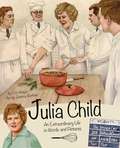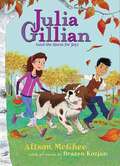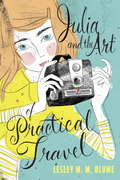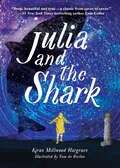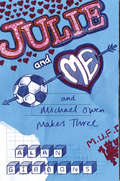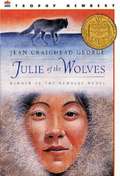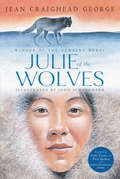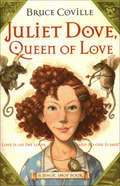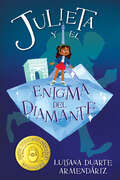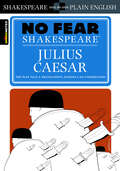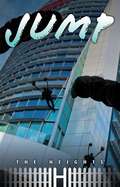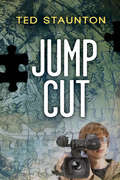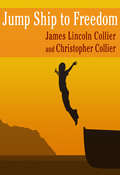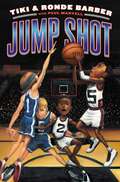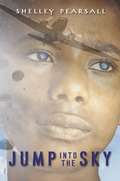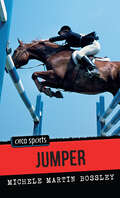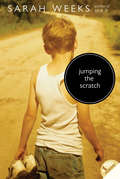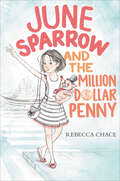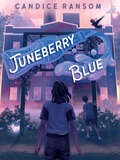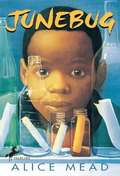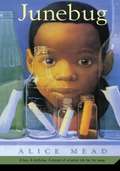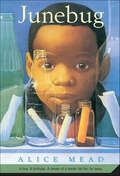- Table View
- List View
Julia Child: An Extraordinary Life in Words and Pictures
by Erin HagarJulia Child knew how to have fun, and she also knew how to whip up a delightful meal. After traveling around the world working for the U. S. government, Julia found her calling in the kitchen and devoted her life to learning, perfecting, and sharing the art of French cuisine. This delicious, illustrated biography is a portrait of the remarkable woman, author, and TV personality who captured our hearts with her sparkling personality. "Bon appétit!”
Julia Gillian (Julia Gillian)
by Alison Mcghee Drazen KozjanSo far, fifth grade at Lake Harriet Elementary School is not exactly a thing of joy. Julia Gillian's best friend, Bonwit Keller, is keeping a secret from her. Trumpet lessons with Mr. Mixler, her favorite teacher, are much harder than expected. And most upsetting of all, the kind lunch lady has been replaced by a tyrant known as the Dumpling Man. Where is the joy? Amidst all this, Julia Gillian starts keeping secrets of her own--secrets that feel an awful lot like lies. To set things right, she will have to learn a little bit about friendship and honesty.
Julia and the Art of Practical Travel
by Lesley M. BlumeWhen her grandmother dies and the once-majestic family estate is sold, eleven-year-old Julia Lancaster and her aunt Constance must take to the road to find Julia's long-lost mother. They bring with them only the most practical travel things--silver candlestick holders, a few Oriental carpets, some steamer trunks, and Julia's beloved Brownie camera, which she will use to document their journey across 1960s America. On the road, Julia and her aunt meet a cast of peculiar characters, including guitar-strumming hippies in Greenwich Village, a legendary voodoo queen in New Orleans, the honorable proprietor of the World's End Cattle Ranch in Texas, and the colorful sheriff of Gold Point, Nevada (population: 1), who also happens to be the town's mayor, fire chief, and reverend. But will they find Julia's mother and a place to call home? Poignant, engaging, and funny, Lesley M. M. Blume's new novel is a meditation on the thin line between being an insider and being an outsider, and the deep-rooted need we all have to find a place where we can feel at home.
Julia and the Shark
by Kiran Millwood Hargrave"Deep beautiful, and true--a classic from cover to cover." --#1 New York Times bestselling author Eoin ColferThere are more secrets in the ocean than in the sky... Ten-year-old Julia loves the mysteries of the ocean and marine biology, just like her scientist mother. Her family is spending the summer on a remote island where her mom is searching for the elusive Greenland shark, a creature that might be older than the trees, and so rare that it&’s only been seen a few times. But the ocean is reluctant to give up its secrets, and Julia tries not to worry as her mother returns disappointed at the end of each day. Determined to prove that the shark is real, Julia sets off on a quest to find it herself, armed with a set of coordinates, a compass, and her trusty rain jacket. She soon realizes that there are some journeys you shouldn&’t go on alone. As Julia comes face to face with the dark and wondrous truths of the sea, she finds the strength to leave the shark in the depths and kick up towards the light. Through a unique blend of poetic prose and stunning illustrations, Julia and the Shark tells an unforgettable story full of dark depths and starry skies, courage and hope. This lyrical, deeply moving middle grade novel about one family&’s fierce love and resilience is perfect for starting conversations about mental health and how it&’s okay to not be okay.
Julie and Me and Michael Owen Makes Three
by Alan GibbonsFor Terry Payne, life is not much fun. His parents are splitting up, and he's fallen desperately in love with the gorgeous new girl at school, who doesn't even know he exists. To top it all off, his beloved football team - the mighty Man U - are on a losing streak.As Terry sees Man U lose to Liverpool, watches in horror as arch-rival and school golden boy showers the beautiful Julie with attention, and discovers the object of his affections is ... a Liverpool fan, he starts to think that things can't get much worse.After all, it's a close contest in Life versus Football - and there can only be one winner. Can't there?Hilarious and heart-warming, this is a touching story about the ups and downs of life, love, and more importantly, football, from award-winning author, Alan Gibbons.
Julie of the Wolves (Julie Of The Wolves Ser. #1)
by Jean Craighead George John SchoenherrNIMAC-sourced textbook
Julie of the Wolves (Julie of the Wolves #1)
by Jean Craighead GeorgeFaced with the prospect of a disagreeable arranged marriage or a journey acoss the barren Alaskan tundra, 13-year-old Miyax chooses the tundra. She finds herself caught between the traditional Eskimo ways and the modern ways of the whites. Miyax, or Julie as her pen pal Amy calls her, sets out alone to visit Amy in San Francisco, a world far away from Eskimo culture and the frozen land of Alaska.<P><P> During her long and arduous journey, Miyax comes to appreciate the value of her Eskimo heritage, learns about herself, and wins the friendship of a pack of wolves. After learning the language of the wolves and slowly earning their trust, Julie becomes a member of the pack.<P> Newbery Medal Winner
Julie of the Wolves (Julie of the Wolves #1)
by Jean Craighead George John SchoenherrJean Craighead George's Newbery Medal-winning classic about an Eskimo girl lost on the Alaskan tundra now features bonus content. This edition, perfect for classroom or home use, includes John Schoenherr's original scratchboard illustrations throughout, as well as extra materials such as an introduction written by Jean Craighead George's children, the author's Newbery acceptance speech, selections from her field notebooks, a discussion guide, and a further reading guide.Julie of the Wolves is a staple in the canon of children's literature and the first in the Julie trilogy. The survival theme makes it a good pick for readers of other wilderness stories such as My Side of the Mountain, Hatchet, or Island of the Blue Dolphins.To her small Eskimo village, she is known as Miyax; to her friend in San Francisco, she is Julie. When her life in the village becomes dangerous, Miyax runs away, only to find herself lost in the Alaskan wilderness.Miyax tries to survive by copying the ways of a pack of wolves and soon grows to love her new wolf family. Life in the wilderness is a struggle, but when she finds her way back to civilization, Miyax is torn between her old and new lives. Is she Miyax of the Eskimos--or Julie of the wolves?
Julie's Outrageous Idea (The Party Line #10)
by Carrie AustenThis is just too much! Julie's been assigned to write a term paper on the rain forest, but she'd rather get lost in the woods! Still, if she doesn't do this report, her grade could become an endangered species. Then a funny thing happens. Once Julie gets started on her project, she just can't seem to stop. Not only is she fascinated by the rain forest, she becomes really involved in the environment. Her bike-a-thon idea gets her whole school pedaling for ecology. But now it looks as if The Party Line won't survive all of Julie's wild new ideas. Can they strike a happy balance between Julie's plans and their business? Or will they be up to their elbows in soapsuds forever? It's the craziest Party Line problem yet--soapsuds insanity! Get on The Party Line! Meet Julie, Allie, Becky, and Rosie in this fun-filled series about friendship, growing up, and having a good time!
Juliet Dove, Queen of Love: Juliet Dove, Queen Of Love; And The Monsters Ring (Magic Shop Book #5)
by Bruce CovilleShy Juliet Dove leaves Mr. Elives' magic shop with Helen of Troy's amulet--a virtual man magnet. Juliet doesn't know what she's got, but soon every boy in town is swoony for her. Yet, much as she'd like to lose all the unwanted attention, she can't: The amulet won't come off!A sidesplittingly funny, heartbreaking whirlwind of a book about the high cost of loving, from the award-winning author of My Teacher Is an Alien and The Unicorn Chronicles.
Julieta y el enigma del diamante: (Julieta and the Diamond Enigma)
by Luisana Duarte ArmendárizFrom the Mixed up Files of Mrs. Basil E. Frankweiler se encuentran con Merci Suarez en esta inteligente novela de misterio de grado medio sobre un diamante que desapareció del Louvre, y la dulce y valiente chica que resuelve el caso. From the Mixed-Up Files of Mrs. Basil E. Frankweiler meets Merci Suarez in this smart young middle-grade mystery about a diamond gone missing from the Louvre and the sweet and spunky girl who cracks the case.¡Julieta, de nueve años, finalmente está a punto de poner un pin morado en el mapa mundial de viajes de su familia! Se va a París para ayudar a su padre, un encargado del arte, a recolectar piezas para una nueva exposición en el Museo de Bellas Artes de Boston. Lamentablemente, dejan en casa a la madre de Julieta, que esta muy embarazada, pero están seguros de que llegarán a tiempo para el nacimiento del bebé. Julieta ve lo mejor de París: la Torre Eiffel, el Sacré-Cœur y arte excelente. Pero las cosas salen mal cuando ella y su padre encuentran a un ladrón que roba la pieza más preciada del Louvre, el Diamante Regente, un diamante maldito de valor incalculable con una historia turbia. Cuando Julieta corre en busca de ayuda ¡accidentalmente libera al ladrón! Ahora el trabajo de papá está en riesgo y él se a convertido en sospechoso. ¿Podrá Julieta determinar quién es realmente el ladrón? ¡Ganador del Premio Tu Books Nuevas Visiones 2018! Nine-year-old Julieta is finally about to put a purple pin in her family's world traveling map! She's off to Paris to help her art-handler dad collect pieces for a new exhibit at the Boston Museum of Fine Arts. Sadly, they must leave Julieta's very pregnant mother behind, but they're sure they'll be back before the baby is born. Julieta sees the best of Paris: the Eiffel Tower, the Sacré-Cœur, and plenty of great art. But things go awry when she and Dad walk in on a thief stealing the Louvre's most prized piece, the Regent Diamond--a priceless cursed diamond with a shady history. When Julieta runs for help, she accidentally frees the thief instead! Now Dad's job is in danger and he's become a suspect. Can Julieta determine who the thief really is before it's too late? Winner of the Tu Books 2018 New Visions Award!
Juliette Gordon Low: America's First Girl Scout
by Kathleen V. KudlinskiPresents a biography of the founder of the Girl Scout movement.
Julius Caesar: No Fear Shakespeare Side-by-Side Plain English (No Fear Shakespeare)
by William Shakespeare SparkNotesThis No Fear Shakespeare ebook gives you the complete text of Julius Caesarand an easy-to-understand translation.Each No Fear Shakespeare containsThe complete text of the original playA line-by-line translation that puts Shakespeare into everyday languageA complete list of characters with descriptionsPlenty of helpful commentary
Jump (The Heights)
by The Editors at the Saddleback PublishingThese traditional reads are brimming with spirited characters and positive values- but with a little extra excitement and bite, so hold on to your hats! Written expressly for the middle grade struggling reader, the series does not contain strong language, edgy themes, or dysfunctional families. In fact, family is the main theme of these titles. And one particular Latino family is the focus with their uncanny knack for finding humor, hope, and coloful personalities- even in unusual circumstances. Written at the lowest reading levels, the story structure is straightforward and moves the reader through the text quickly and efficiently.
Jump Cut (Seven (the Series) #5)
by Ted StauntonSpencer loves movies, but real life is boring, right? When his late grandfather's will reveals the tasks he wants his grandsons to undertake, Spencer thinks he got screwed. He's not going to France or Spain or Africa. He's not even getting a cool tattoo, like his younger brother. No, he's going to Buffalo to get a kiss from an ancient movie star. Gross. And he's supposed to film it. Grosser. But Spencer hasn't bargained on Gloria Lorraine, star of the silver screen back in the day. Gloria has big plans—plans that involve her granddaughter AmberLea, a gun, a baker who might be a gangster, some real gangsters and a road trip to Nowheresville, Ontario. After being shot at, jumping into an icy lake and confronting some angry bikers, Spencer finally realizes that real life can be as exciting (and dangerous) as reel life. Spencer's adventures start in Speed, part of The Seven Prequels and continue in Coda, part of The Seven Sequels.
Jump Ship to Freedom
by James Lincoln Collier Christopher CollierYoung Daniel Arabus and his mother are slaves in the house of Captain Ivers of Stratford, Connecticut. By law they should be free, since Daniel's father fought in the Revolutionary army and earned enough in soldiers' notes to buy his family's freedom. But now Daniel's father is dead, and Mrs. Ivers has taken the notes from his mother. When Daniel bravely steals the notes back, a furious Captain Ivers forces him aboard a ship bound for the West Indies--and certain slavery. Even if Daniel can manage to jump ship in New York, will he be able to travel the long and dangerous road to freedom?
Jump Shot
by Paul Mantell Tiki Barber Ronde BarberThe Barber brothers know their way around a football field--but can they succeed on the basketball court? Find out in this slam dunk with "lively basketball action and life lessons aplenty (Kirkus Reviews)" from NFL superstars and bestselling authors Tiki and Ronde Barber.As Tiki and Ronde count the days until the start of football season, the basketball coach approaches them looking for new recruits, and Tiki and Ronde sign on. While Hidden Valley Junior High has always been a powerhouse in football, the school has never done as well in basketball. Ronde is a good passer, but he needs Tiki to get free to sink his shots. Tiki doesn't feel the inner confidence he felt on the football field: it's one thing to play in the driveway, but it's another to sink one on the court, when so much is on the line. The brothers need a winning attitude--and they need to bring everyone together to win. That is their only way to victory. Can they do it?
Jump into the Sky
by Shelley PearsallLevi Battle's been left behind all his life. His mother could sing like a bird and she flew away like one, too. His father left him with his grandmother so he could work as a traveling salesman--until Levi's grandmother left this world entirely. Now Levi's staying with his Aunt Odella while his father is serving in the U.S. Army. But it's 1945, and the war is nearly over, and Aunt Odella decides it's time for Levi to do some leaving of his own. Before he can blink, Levi finds himself on a train from Chicago to Fayettville, North Carolina, where his father is currently stationed--last they knew.So begins an eye-opening, life-changing journey for Levi. First lesson: there are different rules for African Americans in the South than there are in Chicago. And breaking them can have serious consequences. But with the help of some kind strangers, and despite the hindrances of some unkind ones, Levi makes his way across the United States--searching for his father and finding out about himself, his country, and what it truly means to belong.Shelley Pearsall has created an unforgettable character in Levi and gives readers a remarkable tour of 1945 America through his eyes. Jump into the Sky is a tour de force of historical fiction from a writer at the very top of her game.From the Hardcover edition.
Jumper (Orca Sports)
by Michele Martin BossleyReese loves horses and longs to be a competitive show-jumper. When the leased horse she rides is sold she is left riding the orneriest horse in the stable. She decides she must find a horse of her own. Her parents can't afford a trained horse so she decides to buy a wild horse at auction. Outbid, she discovers that many of the wild horses are will be sold for slaughter. Determined to save the horses from a terrible fate she finds herself in deeper than she expected and fighting for her life.
Jumping the Scratch
by Sarah WeeksJamie Reardon has always heard that bad things come in threes. So after his cat, Mister, dies, his father leaves, and his aunt Sapphy has an accident that causes her memory to develop a skip, Jamie hopes his life will go back to being as normal as cornflakes. But unfortunately there's one more bad thing in store for Jamie--something he'd give anything to be able to forget--and this one leaves him feeling like a stranger to himself. Jamie tries in vain to find the magic trigger that will help Sapphy's memory jump the scratch, but in the end it's Aunt Sapphy who, along with a curious girl named Audrey Krouch, helps Jamie unravel the mysteries of memory and jump the scratch in his own life.
June Sparrow and the Million-Dollar Penny
by Rebecca ChaceA charming, classic middle grade debut perfect for fans of Three Times Lucky and Because of Winn-Dixie with the most lovable pig since Wilbur in Charlotte’s Web. June Sparrow and her best friend—a miniature pig named Indigo Bunting—have always been just fine on their own. June is a wealthy orphan who’s lived in New York City her whole life. But on June’s twelfth birthday, she suddenly loses her fortune and is forced to move in with an aunt she’s never even met, in the tiny town of Red Bank, South Dakota, a place so small that it doesn’t even have a traffic light.Now June has to live on a farm with grouchy Aunt Bridget, who sees her best friend as potential bacon! Then one day, June finds a mysterious Penny Book that her mother used to keep. She is instantly intrigued by what her mother called the Big One, the rarest and most valuable of all pennies. Finding it could be June’s ticket back to New York and her old life. But the only guide June and Indigo have is a cryptic list her mom left behind.To decode the list and find the Big One, June and Indigo enlist the help of some new friends in Red Bank and turn the town upside down in their search. But the most surprising mystery of all may be what brought June to Red Bank in the first place—and what is most valuable to her in the end.
Juneberry Blue
by Candice RansomTaking inspiration from Sleeping Beauty and charming small towns, this contemporary magical realism novel includes a mistaken destiny, a dying town, and a determined ghost cat.Eleven-year-old Andie Jennings, of Morning Glory, Virginia (population: 8), is set to inherit her family's magic on Midsummer's Eve. And Andie plans to use it to bring her dad home for good from his long-haul trucking job. Except her gift doesn&’t come.But when a see-through cat starts following her, Andie realizes she didn't fail to get her magic at all. Her gift just isn&’t what anyone expected. Turns out, her new ability to communicate with the ghosts she can suddenly see may be the very thing that Morning Glory—and her own family—needs.Inspired by storytelling and tales passed down through generations, Juneberry Blue celebrates the importance of listening to stories--and the people who tell them.
Junebug
by Alice MeadReeve McLain, Jr. --Junebug--has a big dream that keeps him going. He dreams that someday he and his younger sister and mother will move from the awful housing project where drugs, gangs, and guns are part of everyday life. Junebug's tenth birthday is coming up, and he knows the gangs and drug dealers will be after him to join them. But he has a big birthday plan to keep his hope alive. He's going to launch his glass-bottle collection filled with notes of his dreams and wishes. Maybe some way, somehow, Junebug's dream will come true.
Junebug (Junebug Ser.)
by Alice Mead Michael HaysNIMAC-sourced textbook <P><P>Some of the stuff that goes on in the Auburn Street Projects, I'm never gonna do. These projects are like some kind of never-never land, like they never got put on a regular map. Nobody comes around here on purpose. It's as if we all got lost, right in the middle of the city. <P><P>Reeve McClain, Jr. -- Junebug -- has decided to skip his birthday. Since ten is the age when boys in the projects are forced to join gangs or are ensnared by drug dealers, Junebug would rather remain nine. Still, he does have a birthday wish: to someday become a ship's captain and sail away. So Junebug comes up with a plan to launch a flotilla, fifty glass bottles containing notes with his wish, in the hope that someone somewhere will help to make his dream come true. <P><P>Lexile Measure: 570L
Junebug (Junebug Ser.)
by Alice MeadSome of the stuff that goes on in the Auburn Street Projects, I'm never gonna do. These projects are like some kind of never-never land, like they never got put on a regular map. Nobody comes around here on purpose. It's as if we all got lost, right in the middle of the city.Reeve McClain, Jr. -- Junebug -- has decided to skip his birthday. Since ten is the age when boys in the projects are forced to join gangs or are ensnared by drug dealers, Junebug would rather remain nine. Still, he does have a birthday wish: to someday become a ship's captain and sail away. So Junebug comes up with a plan to launch a flotilla, fifty glass bottles containing notes with his wish, in the hope that someone somewhere will help to make his dream come true.
